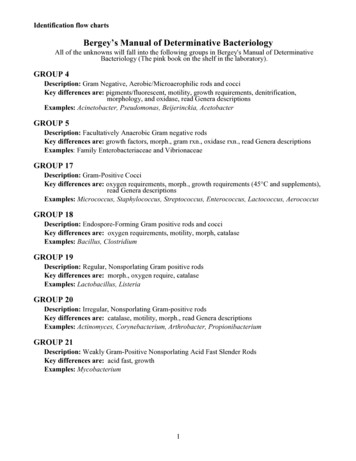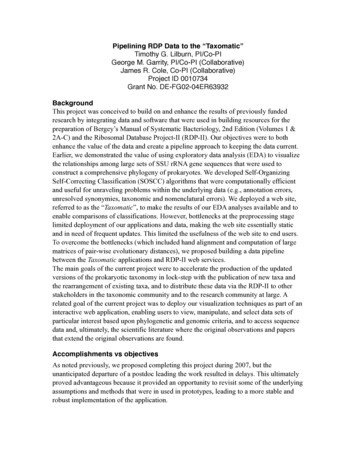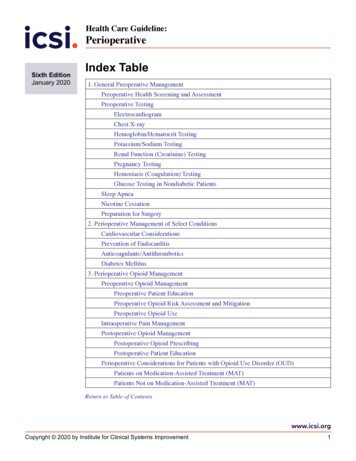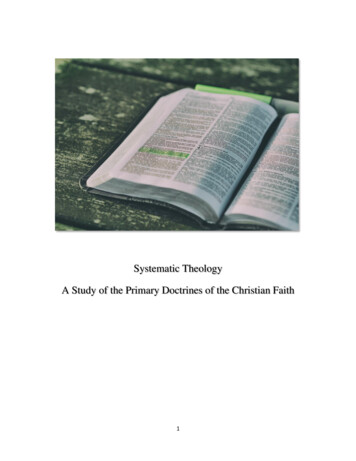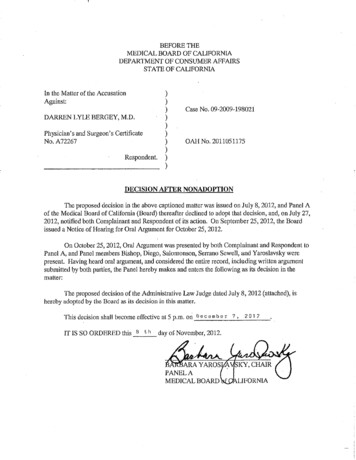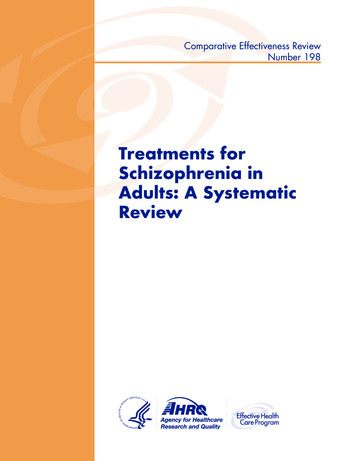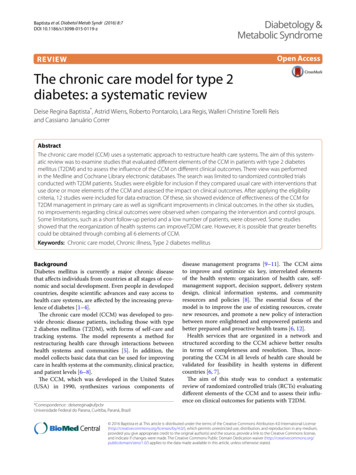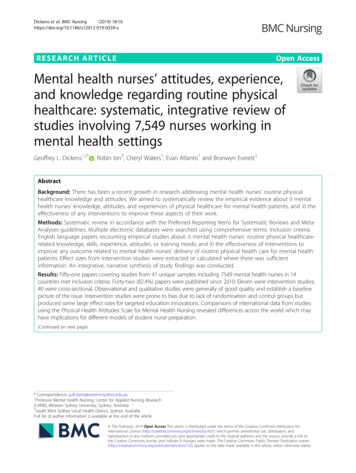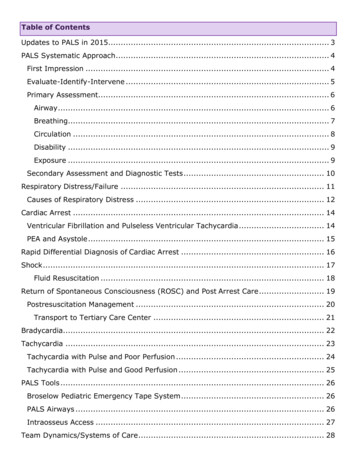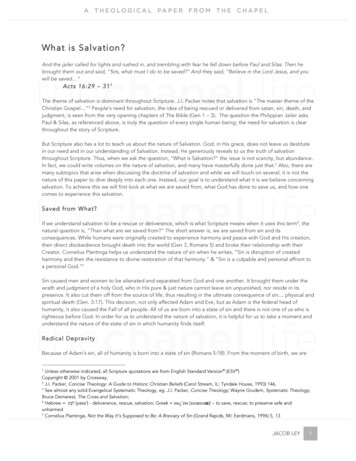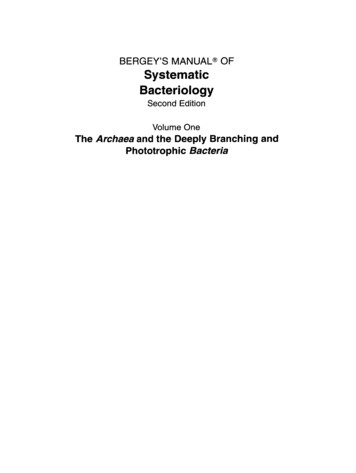
Transcription
BERGEY'S MANUAL OFSystematicBacteriologySecond EditionVolume OneThe Archaea and the Deeply Branching andPhototrophic Bacteria
Springer Science Business Media, LLC
BERGEY'S MANUAL OFSystematicBacteriologySecond EditionVolume OneThe Archaea and the Deeply Branching andPhototrophic BacteriaDavid R. BooneRichard W. CastenholzEDITORS, VOLUME ONEGeorge M. GarrityEDITOR-I N-CH IEFEDITORIAL BOARDJames T. Staley, Chairman, David R. Boone, Vice Chairman,Don J. Brenner, Richard W. Castenholz, George M. Garrity, MichaelGoodfellow, Noel R. Krieg, Fred A. Rainey, Karl-Heinz SchleiferWITH CONTRIBUTIONS FROM 105 COLLEAGUESSpringer
Library of Congress Cataloging-in-Publication DataBergey's manual of systematic bacteriology / David R. Boone, Richard W. Castenholz,editors, volume 1 ; George M. Garrity, editor-in-chief.-2nd ed.p.cm.Includes bibliographical references and index.Contents: v. 1. The archaea and the deeply branching and phototrophic bacteria.1. Bacteria-Classification. 1. Title: Systematic bacteriology.III. Castenholz, Richard W. IV. Garrity, George M.QR81.B462001579.3'01 '2-dc21II. Boone, David R.2001020400With 330 illustrationsThe following proprietary names of products are used in this volume: Casamino@ acids; Vector NTI ;XLI0-G0ld ; Gelrite ; Tryptone@ ; Phytagel@ ; bio-Trypcase@ ; Trypticase ; Oxoid purified agar.Printed on acid-free paper.First edition published 1984-1989 by Bergey's Manual Trust and Williams & Wilkins, Baltimore. 2001 Springer Science Business Media New YorkOriginally published by Bergy's Manual Trust in 2001Softcover reprint ofthe hardcover Ist edition 2001Ali rights reserved. This work may not be translated or copied in whole or in part without the writtenpermission of the publisher Springer Science Business Media, LLCexcept for brief excerpts in connection with reviews or scholarly analysis. Use in connection withany form of information storage and retrieval, electronic adaptation, computer software, or by similaror dissimilar methodology now known or hereafter developed is forbidden.The use of general descriptive names, trade names, trademarks, etc., in this publication, even if theformer are not especially identified, is not to be taken as a sign that such names, as understood by theTrade Marks and Merchandise Marks Act, may accordingly be used freely by anyone.While the advice and information in this book are believed to be true and accurate at the date of goingto press, neither the authors nor the editors nor the publisher can accept any legal responsibility for anyerrors or omissions that may be made. The publisher makes no warranty, express or implied, with respectto the material contained herein.Production coordinated by Impressions Book and Journal Services, Ine., and managed by FrederickBartlett, Theresa Komak, and Catherine Lyons; manufacturing supervised by Jacqui Ashri.Typeset by Impressions Book and Joumal Services, Ine., Madison, WI.987654321SPIN 10711344ISBN 978-1-4419-3159-7ISBN 978-0-387-21609-6 (eBook)DOI 10.1007/978-0-387-21609-6
EDITORIAL BOARD AND TRUSTEESOF BERGEYS MANUAL TRUSTJames T. Staley, ChairmanDavid R Boone, Vice ChairmanDon J. BrennerRichard W. CastenholzGeorge M. GarrityMichael GoodfellowNoel R KriegFred A. RaineyKarl-Heinz SchleiferJohn G. Holt, EmeritusJohn Liston, EmeritusJames W. Moulder, EmeritusRG.E. Murray, EmeritusCharles F. Niven, Jr., EmeritusNorbert Pfennig, EmeritusPeter H.A. Sneath, EmeritusJoseph G. Tully, EmeritusStanley T. Williams, Emeritus
Preface to the Second Edition of Bergey's Manua/ of Systematic Bacteri%gyThere is a long-standing tradition for the Editors of each successive edition of Bergey's Manual to open their respective volumeswith the observation that the new edition is adeparture from theearlier ones. We shall not waver frolP this tradition, as the verynature of our field compels us to make this pronouncement. Systematic bacteriology (or perhaps systematic procaryotic biology)is a dynamic field, driven by constant theoretical and methodological advances that will ultimately lead to a more perfect anduseful classification scheme.Since publication of the First Edition of the Systematics Manual,we have witnessed a major shift in how we view the relationshipsamong Bacteria and Archaea. While the possibility of a universallyapplicable natural classification was evident as the First Editionwas in preparation, it is only recently that the sequence databasesbecame large enough, and the taxonomie coverage broadenough, to make such an arrangement feasible. We have re liedheavily upon these data in organizing the contents of this editionof Bergey's Manual 0/ Systematic Bacteriology, which will follow a phylogenetic framework based on analysis of the nucleotide sequence of the small ribosomal subunit RNA, rather than a phenotypic structure. This departs from the First Edition, as well asthe Eighth and Ninth Editions of the Determinative Manual. Whilethe rationale for presenting the content of this edition in such amanner should be evident to most readers, they should bear inmind that this edition, as have all preceding ones, represents aprogress report rather than a final classification of procaryotes.The Editors remind the readers that the Systematics Manual isa peer-reviewed collection of chapters, contributed by authorswho were invited by the Trust to share their knowledge and expertise of specific taxa. Citation should refer to the author, thechapter title, and inclusive pages rather than to the Editors. TheTrust is indebted to all ofthe contributors and reviewers, withoutwhom this work would not be possible. The Editors are gratefulfor the time and effort that each expended on behalf of the en tirescientific community. We also thank the authors for their goodgrace in accepting comments, criticisms, and editing of theirmanuscripts. We would also like to recognize the special effortsof Drs. Hans Trüper and Brian Tindall for their assistance onmatters of nomenclature and etymology and Dr. Aharon Orenfor his critical reading of large portions of the Manual.We would like to express our thanks to the Department ofMicrobiology and Molecular Genetics at Michigan State University for housing our headquarters and editorial office and forproviding a congenial and supportive environment for microbialsystematics. We would also like to thank Connie Williams not onlyfor her expert secretarial assistance, but also for unflagging dedication to the mission of Bergey's Manual Trust and Dr. DeniseSearles for her editorial assistance and diligence in verifYingcountless pie ces of critical information, along with Heather Everett, Alissa Wesehe, and Mathew Winters for their assistance infact-checking and compilation of the bibliography.A project such as the Systematics Manual also requires thestrong and continued support of a dedicated publisher, and wehave been most fortunate in this regard. We would also like toexpress our gratitude to Springer-Verlag for supporting our efforts and for the development of the Bergey's Document TypeDefinition (DTD). We would especially like to thank our Executive Editor, Dr. Robert Badger, for his courage, patience, understanding, and support; Catherine Lyons for her expertise in designing and developing our DTD, and Terry Kornak and FredBartlett for their efforts during the pre-production and production phases. We would also like to acknowledge the support ofArborText, Inc., for providing us with state-of-the-art SGML development and editing tools at reduced cost. Lastly, I would liketo express my personal thanks to my fellow trustees for providingme with the opportunity to participate in this effort, to Drs. DavidBoone and Richard Castenholz for their enormous efforts as volurne editors and to my wife, Nancy, and daughter, Jane, for theirpatience, tolerance, and support.Comments on this edition are welcomed and should be directed to Bergey's Manual Trust, Department of Microbiologyand Molecular Genetics, Giltner Hall, Michigan State University,East Lansing, MI, USA 48824-1101. Email: garrity@pilot.msu.eduGeorge M. Garrityvii
Preface to the First Edition of Bergey's Manua/ of Systematic Bacteri%gyMany mierobiologists advised the Trust that a new edition of theManual was urgendy needed. Of great concern to us was thesteadily increasing time interval between editions; this intervalreached a maximum of 17 years between the seventh and eightheditions. To be useful the Manual must reflect relatively recentinformation; a new edition is soon dated or obsolete in partsbecause of the nearly exponential rate at which new informationaccumulates. A new approach to publication was needed, andfrom this conviction came our plan to publish the Manual as asequence of four subvolumes concerned with systematie bacteriology as it applies to taxonomy. The four subvolumes are dividedroughly as follows: (a) the Gram-negatives of general, medieal orindustrial importance; (b) the Gram-positives other than ac tinomycetes; (c) the archaeobacteria, cyanobacteria and remaining Gram-negatives; and (d) the actinomycetes. The Trust believed that more attention and care could be given to preparationof the various descriptions within each subvolume, and also thateach subvolume could be prepared, published, and revised as thearea demanded, more rapidly than could be the case if the Manual were to remain as a single, comprehensive volume as in thepast. Moreover, microbiologists would have the option of purchasing only that partieular subvolume containing the organismsin whieh they were interested.The Trust also believed that the scope of the Manual neededto be expanded to include more information of importance forsystematic bacteriology and bring together information dealingwith ecology, enriehment and isolation, descriptions of speciesand their determinative characters, maintenance and preservation, all focused on the illumination of bacterial taxonomy. Toreflect this change in scope, the tide ofthe Manualwas changedand the primary publication becomes Bergey's Manual of SystematicBacteriology. This contains not only determinative material suchas diagnostic keys and tables useful for identification, but also allof the detailed descriptive information and taxonomie comments. Upon completion of each subvolume, the purely determinative information will be assembled for eventual incorporation into a much smaller publication whieh will continue theoriginal name of the Manual, Bergey's Manual ofDeterminative Bacteriology, which will be a similar but improved version of the present Shorter Bergey's Manual. So, in the end there will be two publieations, one systematie and one determinative in character.An important task of the Trust was to decide which generashould be covered in the first and subsequent subvolumes. Wewere assisted in this decision by the recommendations of ourAdvisory Committees, composed of prominent taxonomie au-thorities to whom we are most grateful. Authors were chosen onthe basis of constant surveillance of the literature of bacterialsystematics and by recommendations from our Advisory Committees.The activation of the 1976 Code had introduced some novelproblems. We decided to include not only those genera that hadbeen published in the Approved Lists ofBacterial Names in January 1980 or that had been subsequendy validly published, butalso certain genera whose names had no current standing in nomenclature. We also decided to include descriptions of certainorganisms whieh had no formal taxonomie nomenclature, suchas the endosymbionts of insects. Our goal was to omit no important group of cultivated bacteria and also to stimulate taxonomieresearch on "neglected" groups and on some groups of undoubted bacteria that have not yet been cultivated and subjectedto conventional studies.The invited authors were provided with instructions and exemplary chapters inJune 1980 and, although the intended deadline for receipt of manuscripts was March 1981, all contributionswere assembled in January 1982 for the final preparations. TheManual was forwarded to the publisher in June 1982.So me readers will note the consistent use of the stern -var instead of -type in words such as biovar, serovar and pathovar. Thisis in keeping with the recommendations of the BacteriologiealCode and was done against the wishes of so me of the authors.We have deleted much of the synonymy of scientific nameswhich was contained in past editions. The adoption of the newstarting date ofJanuary 1,1980 and publication ofthe ApprovedLists of Bacterial Names has made mention of past synonymy obsolete. We have included synonyms of a name only if they havebeen published since the new starting date, or if they were alsoon the Approved Lists and, in rare cases with certain pathogens,if the mention of an old name would help readers associate theorganism with a clinical problem. If the reader is interested intracing the history of a name we suggest he or she consult pasteditions of the Manualor the Index Bergeyana and its Supplement.In citations of names we have used the abbreviation AL to denotethe inclusion of the name on the Approved Lists of BacterialNames and VP to show the name has been validly published.In the matter of citation of the Manual in the scientific literature we again stress the fact that the Manual is a collection ofauthored chapters and the citation should refer to the author,the chapter tide and its inclusive pages, not the Editor.To all contributors, the sincere thanks of the Trust is due; theEditor is especially grateful for the good grace with which theix
xPREFACE TO THE FIRST EDITIONauthors accepted comments, criticisms and editing of their manuscripts. It is only because of the voluntary and dedicated effortsof these authors that the Manual can continue to serve the science of bacteriology on an international basis.A number of institutions and individuals deserve special acknowledgment from the Trust for their help in bringing aboutthe publication of this volume .
Preface to the First Edition of Bergey's Manua/ of Determinative Bacteri%gyThe elaborate system of classification of the bacteria into families,tribes and genera by a Committee on Characterization and Classification of the Society of American Bacteriologists (1911,1920)has made it very desirable to be able to place in the hands ofstudents a more detailed key for the identification of species thanany that is available at present. The valuable book on "Determinative Bacteriology" by Professor F. D. Chester, published in1901, is now ofvery little assistance to the student, and all previous classifications are of still less value, especially as earliersystems of classification were based entirely on morphologie characters.It is hoped that this manual will serve to stimulate efforts toperfeet the classification of bacteria, especially by emphasizingthe valuable features as weIl as the weaker points in the newsystem which the Committee of the Society of American Bacteriologists has promulgated. The Committee does not regard theclassification of species offered here as in any sense final, butmerely a progress re port leading to more satisfactory classification in the future.The Committee desires to express its appreciation and thanksto those members of the society who gave valuable aid in thecompilation of material and the classification of certain species.The assistance of all bacteriologists is earnestly solicited in thecorrection of possible errors in the text; in the collection ofdescriptions of all bacteria that may have been omitted from thetext; in supplying more detailed descriptions of such organismsas are described incompletely; and in furnishing complete descriptions of new organisms that may be discovered, or in directing the attention of the Committee to publications of suchnewly described bacteria.David H. Bergey, ChairmanFrancis C. HarrisonRobert S. BreedBernard W. HammerFrank M. HuntoonCommittee on Manual.August, 1923.xi
ContentsPrefaee to the Seeond Edition of Bergey's Manual of SystematicBacteriology .Prefaee to the First Edition of Bergey's Manual of SystematicBacteriology .Prefaee to the First Edition of Bergey's Manual of DeterminativeBacteriology .Contributors .The History of Bergey's Manual . . . . . . . . . . . . . . . . . . . . . . . . . . . . . . . . . . .On Using the Manual . . . . . . . . . . . . . . . . . . . . . . . . . . . . . . . . . . . . . . . . . .Proearyotie Domains .Classifieation of Proearyotie Organisms and the Coneept of BaeterialSpeeiation .Identifieation of Proearyotes .Numerieal Taxonomy .Polyphasie Taxonomy .Overview: A Phylogenetie Baekbone and Taxonomie Framework forProearyotie Systematies .Nueleie Aeid Probes and Their Applieation in EnvironmentalMierobiology .Baeterial Nomenelature .Etymology in Nomenelature of Proearyotes .Mierobial Eeology-New Direetions, New Importanee .Culture Colleetions: An Essential Resouree for Mierobiology .Intelleetual Property of Proearyotes .The Road Map to the Manual . . . . . . . . . . . . . . . . . . . . . . . . . . . . . . . . . . . . .viiixxixix115212733394349678389101111115119DOMAIN ARCHAEAPHYLUM AICrenarchaeota .Class I. Thermoprotei .Order I. Thermoproteales . . . . . . . . . . . . . . . . . . . . . . . . . . . . . . . . . . . .Family I. Thermoproteaceae . . . . . . . . . . . . . . . . . . . . . . . . . . . . . . . . .Genus I. Thermoproteus .Genus 11. Caldivirga .Genus 111. Pyrobaculum .Genus IV. Thermocladium .Family 11. Thermofilaceae . . . . . . . . . . . . . . . . . . . . . . .Genus I. Thermofilum .Order 11. Desulfurococcales .Family I. Desulfurococcaceae . . . . . . . . . . . . . . . . . . . . . . . . . . . . . . . .Genus I. Desulfurococcus .Genus 11. Aeropyrum .Genus 111. Ignicoccus .Genus IV. Staphylothermus .Genus V. Stetteria .Genus VI. Sulfophobococcus 87188xiii
xivCONTENTSGenus VII. Thermodiscus . . . . . . . . . . . . . . . . . . . . . . . . . . . . . . . . .Genus VIII. Thermosphaera .Family 11. Pyrodictiaceae .Genus I. Pyrodictium .Genus 11. Hyperthermus . . . . . . . . . . . . . . . . . . . . . . . . . . . . . . . . . .Genus 111. Pyr%bus .Order 111. Suff%ba/es .Family I. Suff%baceae .Genus I. Suff%bus .Genus 11. Acidianus .Genus 111. Metallosphaera .Genus IV. Stygi%bus .Genus V. Suffurisphaera .Genus VI. Suffurococcus .189190191192195196198198198202204207208209PHYLUM AllEuryarchaeota .211Taxonomy of Methanogenic Archaea . . . . . . . . . . . . . . . . . . . . . . . . . . . . . . .Class I. Methanobacteria .Order Methanobacteriales .Family I. Methanobacteriaceae .Genus I. Methanobacterium .Genus 11. Methanobrevibacter . . . . . . . . . . . . . . . . . . . . . . . . . . . . . .Genus 111. Methanosphaera .Genusl Me ano ermobacrer .Family 11. Methanothermaceae .Genus I. Methanothermus .Class 11. Methanococci . . . . . . . . . . . . . . . . . . . . . . . . . . . . . . . . . . . . . . . . .Order I. Methanococca/es .Family I. Methanococcaceae .Genus I. Methanococcus .Genus 11. Methanothermococcus .Family 11. Methanoca/dococcaceae .Genus I. Methanoca/dococcus .Genus 11. Methanotorris .Order 11. Methanomicrobia/es .Family I. Methanomicrobiaceae .Genus I. Methanomicrobium . . . . . . . . . . . . . . . . . . . . . . . . . . . . . . .Genus 11. Methanoculleus . . . . . . . . . . . . . . . . . . . . . . . . . . . . . . . . .Genus 111. Methanofollis .Genus IV. Methanogenium .Genus V. Methano/acinia .Genus VI. Methanop/anus .Family 11. Methanocorpuscu/aceae .Genus I. Methanocorpuscu/um . . . . . . . . . . . . . . . . . . . . . . . . . . . .Family 111. Methanospirillaceae .Genus I. Methanospirillum .Genus Incertae Sedis I. Methanoca/cu/us .Order 111. Methanosarcina/es .Family I. Methanosarcinaceae .Genus I. Methanosarcina .Genus 11. Methanococcoides .Genus 111. Methanoha/obium . . . . . . . . . . . . . . . . . . . . . . . . . . . . . . .Genus IV. Methanoha/ophilus .Genus V. Methan%bus .Genus VI. Methanosa/sum .Family 11. Methanosaetaceae 269276279281283287289
xvCONTENTSGenus I. Methanosaeta .Class 111. Halobacteria .Order I. Halobacteriales .Family I. Halobacteriaceae .Genus I. Halobacterium .Genus 11. Haloarcula .Genus 111. Halobaculum .Genus IV. Halococcus .Genus V. Haloferax .Genus VI. Halogeometrieum . . . . . . . . . . . . . . . . . . . . . . . . . . . . . .Genus VII. Halorubrum .Genus VIII. Haloterrigena . . . . . . . . . . . . . . . . . . . . . . . . . . . . . . . . .Genus IX. Natrialba .Genus X. Natrinema .Genus XI. Natronobacterium .Genus XII. Natronoeoceus .Genus XIII. Natronomonas . . . . . . . . . . . . . . . . . . . . . . . . . . . . . . . .Genus XIV. Natronorubrum .Class IV. Thermoplasmata .Order I. Thermoplasmatales . . . . . . . . . . . . . . . . . . . . . . . . . . . . . . . .Family I. Thermoplasmataceae . . . . . . . . . . . . . . . . . . . . . . . . . . . . . . .Genus I. Thermoplasma . . . . . . . . . . . . . . . . . . . . . . . . . . . . . . . . .Family 11. Picrophilaeeae .Genus I. Picrophilus . . . . . . . . . . . . . . . . . . . . . . . . . . . . . . . . . . . . .Class IV. Thermoeoeci .Order I. Thermoeoecales .Family I. Thermococcaceae .Genus I. Thermococcus . . . . . . . . . . . . . . . . . . . . . . . . . . . . . . . .Genus 11. Pyrococcus . . . . . . . . . . . . . . . . . . . . . . . . . . . . . . . . . . . .Class VI. Archaeoglobi . . . . . . . . . . . . . . . . . . . . . . . . . . . . . . . . . . . . . . . . .Order I. Archaeoglobales .Family I. Archaeoglobaeeae .Genus I. Archaeoglobus . . . . . . . . . . . . . . . . . . . . . . . . . . . . . . . . . .Genus 11. Ferroglobus .Class VII. Methanopyri . . . . . . . . . . . . . . . . . . . . . . . . . . . . . . . . . . . . . . . . .Order I. Methanopyrales . . . . . . . . . . . . . . . . . . . . . . . . . . . . . . . . . . . . . .Family I. Methanopyraeeae .Genus I. Methanopyrus 352353353353354DOMAIN BACTERIAPHYLUM BIAquificae .359Class I. Aquificae .Order I. Aquifieales .Family I. Aquifieaeeae .Genus I. Aquifex .Genus 11. Calderobacterium .Genus 111. Hydrogenobaeter .Genus IV. Thermocrinis .Genus Incertae Sedis I. Desulfurobacterium .359359360360362363364366PHYLUM BIIThermotogae .369Class I. Thermotogae .Order I. Thermotogales .Family I. Thermotogaceae .Genus I. Thermotoga . . . . . . . . . . . . . . . . . . . . . . . . . . . . . . . . . . . .369369370370
CONTENTSxviGenusGenusGenusGenus11. Fervidobacterium .111. Geotoga .IV. Petrotoga .V. Thermosipho .PHYLUM BillThermodesulfobacteria.375377382385. .389Class I. Thermodesulfobacteria . .Order I. Thermodesulfobacteriales . .Family I. ThermodesulfobacteriaceaeGenus I. Thermodesulfobacterium389389390390PHYLUM BIV"Deinococcus-Thermus" .395Class I. Deinococci .Order I. Deinococcales .Family I. Deinococcaceae .Genus I. Deinococcus .Order 11. Thermales .Family I. Thermaceae .Genus I. Thermus .Genus 11. Meiothermus . . . . . . . . . . . . . . . . . . . . . . . . . . . . . . . . . . .395395395396403403404414PHYLUM BVChrysiogenetes .421Class I. Chrysiogenetes . . . . . . . . . . . . . . . . . . . . . . . . . . . . . . . .Order I. Chrysiogenales .Family I. Chrysiogenaceae . . . . . . . . . . . . . . . . . . . . . . . . . . . . . . . . . .Genus I. Chrysiogenes .421421421422PHYLUM BVIChloroflexi .427Class I. "Chloroflexi" .Order I. "Chloroflexales" . . . . . . . . . . . . . . . . . . . . . . . . . . . . . . . . . . . . . .Family I. "Chloroflexaceae" . . . . . . . . . . . . . . . . . . . . . . . . . . . . . . . . . .Filamentous Anoxygenic Phototrophic Bacteria .Genus I. Chloroflexus .Genus 11. Chloronema .Genus 111. Heliothrix . . . . . . . . . . . . . . . . . . . . . . . . . . . . . . . . . . . . .Genus IV. Oscillochloris .Order 11. "Herpetosiphonales" . . . . . . . . . . . . . . . . . . . . . . . . . . . . . . . . . .Family I. "Herpetosiphonaceae" .Genus I. Herpetosiphon .,.427427427427429437438440444445445PHYLUM BVIIThermomicrobia .447Class I. Thermomicrobia .Order I. Thermomicrobiales .Family I. Thermomicrobiaceae .Genus I. Thermomicrobium .447447447448PHYLUM BVIIINitrospirae .451Class I. "Nitrospira" .Order I. "Nitrospirales" .Family I. "Nitrospiraceae" .Genus I. Nitrospira . . . . . . . . . . . . . . . . . . . . . . . . . . . . . . . . . . . . . .Genus 11. Leptospiri/lum .Genus 111. "Candidatus Magnetobacterium" .Genus IV. Thermodesulfovibrio . . . . .451451451451453457460
xviiCONTENTSPHYLUM BIXDeferribacteres . .Class I. Deferribacteres . .Order I. Deferribacterales . . . . . . . . . . . . . . . . . . . . . . . . . . .
Production coordinated by Impressions Book and Journal Services, Ine., and managed by Frederick Bartlett, Theresa Komak, and Catherine Lyons; manufacturing supervised by Jacqui Ashri. Typeset by Impressions Book and Joumal Services, Ine., Madison, WI. 987654321 SPIN 10711344 ISBN 978-1-4419-3159-7 ISBN 978--387-21609-6 (eBook)
